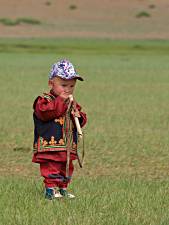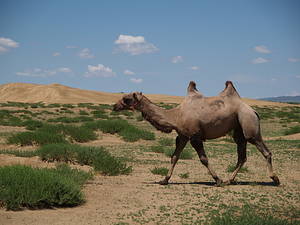Mongolian herd animals:
goats, sheep, cattle, horses, camels
The traditional herd animals of the Mongolians — the five "jewels" or "snouts" — are horses, sheep, goats, cows/yaks and camels.
Horses are a central part of Mongolian identity: though some city dwellers no longer learn how to ride, some Mongolians really do learn how to before they can walk. Jockeys are traditionally under 12 and sometimes as young as 5!
Sheep are the core of flocks, and perhaps the most basic subsistence animal for Mongolian nomads.
Goats are more common in drier areas, where wool production for cashmere is the primary industry. They are more damaging to grasslands than sheep because of their eating style — they pull out plants rather than cropping them — and the effects of this were noticeable in the Gobi.
Camels in Mongolia are of the two-humped Bactrian variety. They have traditionally been important for transport (they are used for moving gers) and status, but have been steadily reducing in numbers, perhaps because of the introduction of mechanised transport. Our ger camp restaraunt in the Gobi had dramatic photos on the wall of rutting male camels, with masses of white foam around their heads — in this state they are apparently very dangerous and have been known to kill wolves.
Mongolian yaks (Bos grunniens) are a kind of "hairy" cow (Bos taurus) — they know how to find forage grass underneath snow, which cows don't, and have other high altitude adaptations. The two can be crossed to give hainag hybrids: these are larger than the parent species and produce more milk. Male hybrids are sterile and are usually used for pulling carts, but females are fertile (and the two F2 backcrosses are also distinguished). The FAO has more on Mongolian yaks.
There are both wild and domesticated donkeys in Mongolia, and pigs are also kept, but neither receives a place in the "five snouts".
A brief history of Mongolian pastoral land use can be found in "Sustaining the Steppes: a Geographical History of Pastoral Land Use in Mongolia", Maria E. Fernandez-Gimenez, Geographical Review, Vol. 89, No. 3 (Jul., 1999), 315-342.

